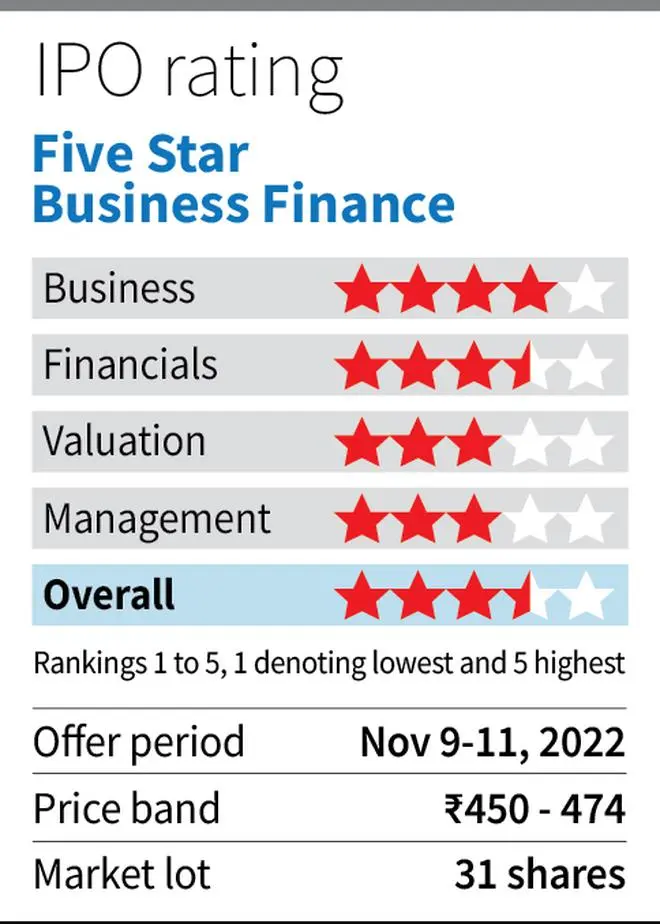It was one of those media briefings when the investment bankers were more formally dressed than the promoter and top executives of Five Star Business Finance. In a sense, it is also a reflection of the company’s core business strategy built on a simple model of formalising the credit requirements of small businesses.
Catering primarily to the ₹3 – 5 lakhs ticket size of loans, this is a segment which large non-banking finance companies such as Shriram City Union, Cholamandalam Investment and Finance Company and Bajaj Finance don’t focus much because it doesn’t fit their cost – returns framework. Neither is it a segment which qualifies under the micro finance definition.
To that extent, Five Star is quite uniquely placed in the lending ecosystem and this makes the initial public offering of Five Star interesting for investors. At the upper end of the price band, the lender’s valuations are 3.2x FY23 estimated price to book. Larger players including AU Small Finance Bank trade at 3 – 5x FY23 estimated price to book. Growth on par with industry over the last 2-3 years, 100 per cent secured lending, good profitability as well as low NPAs justify the valuation. Investors can subscribe to the issue.
Business model and financials
Five Star’s focus is on small businesses where the owner or promoter has a property to offer as security and yet may have to approach pawn brokers or money lenders as banks and large NBFCs turn down the requests. Therefore, 100 per cent of Five Star’s loan book is secured and 95 per cent are secured by self-occupied properties. 60 per cent the lender’s customers are in the service sector – owning and operating kirana shops, automobile mechanic shops, small-time vendors, or domestic essentials. About 25 per cent have semi-skilled outfits like carpenter or plumbing units and the rest are informal sector salaried customers.

Five Star’s yield on advances is about 24 per cent and it is high because it caters to the new-to-credit segment. While the yield may reduce by 100 - 200 bps in the next 12 - 15 months as some of their existing liabilities may be due for repricing, the blended cost of funds at around 11 per cent and the incremental cost of funds at 9 per cent based on FY22 financials bode well for profitability. Net interest margin at 16 - 17.5 per cent is one of the best in the industry, despite having shrunk 150 - 300 bps from the pre-pandemic levels. Though overall cost pressures are likely going forward, investors can expect the company to maintain NIM at these levels, partly due to the fact that incremental costs remain subdued compared to historic levels. While the reduction in NIM vs. FY19 (pre-pandemic) levels has impacted return on equity in a similar range, at 13.86 per cent, Five Star’s ROE appears robust among peers. With no equity dilution in sight (capital adequacy at 75 per cent in FY22), pressure on return profile seems unlikely.
Five Star’s loan book stood at ₹5,297 crore as on June 30, 2022. From FY20 – FY22, its loan growth was 14 per cent (CAGR), tad ahead of the industry. At 1.1 per cent gross non-performing assets (NPA) in Q1 FY23 and 0.7 per cent net NPA, its asset quality is one among the best in segment. Much of the covid-related pain is well behind Five Star, and even at the peak of the pandemic, the asset quality was maintained within the 1 – 1.4 per cent gross NPA bandwidth. The lender draws over 95 per cent of its business from south India, with Tamil Nadu, Andhra Pradesh and Telangana being the key markets.
Key risk
Five Star operates in a segment where scale plays an important role. However, the present risk assessment and underwriting processes are meticulously done on a one-on-one basis with borrowers and the lender adopting a feet-on-the-ground and branch model of operations. While this approach is yielding fruits, it has its limitations. For example, unlike a tech-led lending business where achieving scale is a multiplier of the initial investment, larger scale would mean more costs for the Five Star. If the lender migrates from the current model, it could be detrimental to the loan book quality. Therefore, Five Star would constantly be on a tightrope walk with respect to penetrating into new geographies to achieve scale and maintaining asset quality.









Comments
Comments have to be in English, and in full sentences. They cannot be abusive or personal. Please abide by our community guidelines for posting your comments.
We have migrated to a new commenting platform. If you are already a registered user of TheHindu Businessline and logged in, you may continue to engage with our articles. If you do not have an account please register and login to post comments. Users can access their older comments by logging into their accounts on Vuukle.